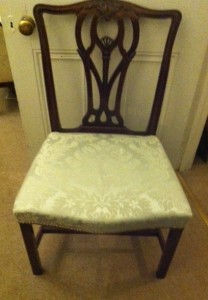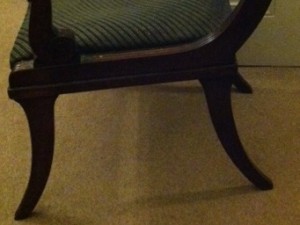27 August 2015
A Matter of Style
by Chin Chin
Well, we’ve all got some explaining to do; all of us, that is, who dragged our children to antique fairs stifling their protests with the mantra “It is a great investment. One day you will thank me. They don’t make more of them. Values can only go one way and that’s up.” That of course was before the values did exactly the opposite and collapsed, leaving all those antiques worth a great deal less than was paid for them.
The truth is that the collecting of antiques is for those to whom they mean something more than just value. If you collect as a way of laying up treasure on earth, you can’t say that you were not warned that your treasures would be corrupted (although, to be fair, St Matthew mentions moth and rust rather than woodworm or change in fashion).
Not all antiques have dropped in value to the same extent, and it will come as no surprise to those of you who read last week’s article about books that rare antiques have held their value better than common ones. One might think that older antiques are rare simply because the passage of years has thinned them out, but a much more important factor is population. According to the Office of National Statistics, the population of England was about 5.74 million in 1750. That is probably about the same level as it was before the black death struck in the 1300s. By the time of the first census, in 1801, the number had climbed to 8.3 million. In the fifty years after that it doubled to 16.8 million, and by 1901 it had reached 30.5 million. All these people needed chairs and tables, and when you bear in mind that huge growth of national prosperity which came with the seven years war (a struggle which ended in 1763 with Britain dominating India following Clive’s victory at Plassey and also North America following Wolfe’s victory at Québec) you will see that a lot of good furniture was required for the homes of the increasingly prosperous middle classes.
That is why early eighteenth century furniture is relatively rare while Regency furniture (made 100 years later) is fairly common. Victorian furniture is more common still. All of it tells a story, however, and putting it in your house can give you a historical perspective.
If you are halfway to being civilised you will have seen the film “Zulu” (and if you haven’t, do buy the DVD as soon as possible). You will remember that the action starts just after the massacre of the British at Isandhlwana. One of the most striking images of that great disaster is that of Lord Chelmsford (the British commander who had caused it by dividing his command) riding back with his column to find his slaughtered comrades, and then spending the night walking sleeplessly amongst the corpses of his friends, haunted by what had happened, in fear of another Zulu attack. It cannot have been a very pleasant experience, but it is certainly a vivid picture. Imagine my feelings then when I looked at the flyleaf of a set of military books in a second-hand bookshop and saw that they were Lord Chelmsford’s personal copies. I didn’t buy them in the end – they belonged in a military museum not on the bookshelves of a private house. But simply to touch the volumes and remember how the man who had read them had spent that terrible night gave the events of 1879 a new freshness.
Not every book belonged to Lord Chelmsford nor was every chair sat upon by George III, Queen Victoria or Jack the Ripper. What then can ordinary old furniture bring to us? Why should a chair from 1750 say any more to us than a chair from 2010? Here it is usually the style which counts rather than the item itself. To understand that you need to go back to the early eighteenth century – the days before Queen Anne died in 1714 – and ask yourself what furniture looked like then. It was certainly a period for fine houses, many of them are still in use, and they required good quality, well-proportion furniture. Much of it was made of oak and walnut, both beautiful woods but not strong enough to support the finest type of carving. So what happened then? Mahogany arrived and revolutionised furniture making. Now there was a wood strong enough to support chairbacks of the sort shown in the illustration  and soon, in 1754, Thomas Chippendale published his famous book “The Gentleman and Cabinet-Maker’s Director”, showing patterns which were then used by cabinetmakers throughout the land.
and soon, in 1754, Thomas Chippendale published his famous book “The Gentleman and Cabinet-Maker’s Director”, showing patterns which were then used by cabinetmakers throughout the land.
That may seem to be just about carving but really it isn’t. Where did the mahogany come from? Cuba and Brazil, the wood often coming to Bristol on ships engaged in the slave trade. Why did mahogany furniture emerge in England not in France? Because the British command of the seas limited French imports so that they could not get hold of the wood. It is all part and parcel of the tapestry of the mid 18th century, a period when Britain vied with France for superiority and won, the period which laid the foundations for the empire on which the sun never set. Whether we like it or not, it is a period which helped form us and its furniture gives us a link to it.
Of course the development of furniture didn’t start and stop with the introduction of mahogany. Different features give away the period in which something was made. Furniture with a Dutch look and spherical “bung” feet was made when England had a Dutch King – William III who married Mary Stuart and came to the throne as joint monarch in 1688. Legs which curve outwards like scimitars (see illustration) indicate the Regency period, the years of Trafalgar and Waterloo. Here the style was light and elegant, before turning heavier and darker under the Victorians. Look at those weighty sideboards and you can see the confidence of the latter age.
indicate the Regency period, the years of Trafalgar and Waterloo. Here the style was light and elegant, before turning heavier and darker under the Victorians. Look at those weighty sideboards and you can see the confidence of the latter age.
These links with history are all very well, but how will old furniture fit into your elegant modern penthouse apartment? The answer to that is “quite well”, provided you choose good quality pieces of furniture and put them in the right places. That is probably obvious with Chippendale and Regency furniture which good design makes easy on the eye. It is certainly the case with the German style of Biedermeier furniture (1815-1830) which combined homeliness with very clean lines, and which has held up in value because of its modern look. It is less clear with heavy Victorian.
That is largely because of the modern obsession with light. Take a north facing basement room and it is naturally dark. If you paint the walls white and put in powerful electric lighting you will get a well-lit dark room. It won’t look great but you will no doubt console yourself with the thought that it is the best that can be done. Try taking the opposite tack. Hang heavy curtains. Paint the walls rich dark and glossy and use gold and brass fittings. Then you will have created a room which is rich and warm. Put a piece of heavy Victorian furniture into that and it will go perfectly.
Old furniture hasn’t been much of an investment recently, and that can often put people off buying it. In fact it is a buying opportunity. Styles change and furniture, like everything else with a limited supply, will pick up value in the end. One word of warning, though. It is important to go for top quality if it is to be a good investment and indeed if you’re going to get pleasure from it. Buying top furniture means spending time with antique dealers and with auctioneers. Still, you have to do it and if the children protest – why, you can tell them that you are making an investment for their future all over again.

